Thor and Delta Rockets Overview
Developed in the 1950's, the PGM-17 Thor IRBM (Intermediate Range Ballistic Missile) soon became one of Americas most important space launchers. Thor rockets, in the Thor-Agena configuration, were used to launch Corona spy satellites.
During the early 1960's, the Thor launcher evolved into the Delta family of space launchers. The Delta series of rockets became one of the worlds most reliable satellite launchers. Current versions, known as Delta IV, will be in service for many years to come.
Thor Rockets

Thor Missle (PGM-17A)
Developed in the 1950's, the Thor IRBM (Intermediate Range Ballistic Missile) first successful launch took place on 20 September 1957. The missile saw service in Great Britain during the early 1960's.
Thor used RP-1 and liquid oxygen as propellants. The missile had a range of around 2,400 km. An LR-79 engine propelled the missile. Two steriable LR-101 vernier rockets, mounted at the missiles base on either side of the main engine, provided directional control.
The Thor missile later evolved into the Delta family of rockets.


Delta Rockets
Delta rockets evolved directly from the Thor family of rockets.
A large number of configurations have been flown. The information below only highlights some of the flown configurations.


Delta-D
Delta-D first flew on 19 August 1964, carrying the Syncom 3 satellite into orbit.
Another Delta-D launched in Intelsat payload on 6 April 1965.

Delta-E
Delta-E was first flown on 6 November 1965. Delta-E payloads included several Explorer, Pioneer, and Intelsat satellites.
The highly sucessful Pioneer 6, 7, 8, and 9 missions were launched on Delta-E rockets.

Delta-M
Delta-M first flew in 1968.

Delta-2914
The Delta-2914 used nine Castor-2 strap-on solid fuel engines.
Delta-2914 first flew on 13 April 1974.

Delta-3920
The Delta-3920 used nine Castor-4 strap-on solid fuel engines.
Delta-3920 first flew on 16 July 1982.
Delta II
Evolved directly from the earlier Thor and Delta rockets, the Delta II became one of the most reliable and frequently flown American rockets.
A large number of Delta-II configurations have flown. The following entries highlight only a few versions.

Delta-7326
Delta-7326 first flew on October 24, 1998. This configuration included three GEM-40 strap-on solid fuel engines.
Delta-7326 rockets flew three missions. Payloads included Deep Space 1, IMAGE, and the Genesis spacecraft.

Delta-7425
Delta-7425 first flew on 11 December 1998. This configuration included four GEM-40 strap-on solid fuel engines.
Delta-7425 rockets flew four missions. Payloads included Mars Climate Orbiter (MCO), Mars Polar Lander (MPL), Midex 2, and the CONTOUR spacecraft.

Delta-7426
This configuration included four GEM-40 strap-on solid fuel engines.
A Delta-7426 rocket launched the Stardust spacecraft on 7 Februry 1999.

.jpg)
Delta-7920H
The Delta-7920H configuration included nine GEM-46 strap-on solid fuel engines.
Three 7920H rockets have flown. The Spitzer space telescope (SIRTF) was launched on 15 August 2003. On 11 June 2008, a 7920H-10 rocket, launched the Fermi (GLAST) gamma-ray space telescope. On 10 September 2011, a 7920H-10 rocket, launched the GRAIL lunar mission (illustration at right). The "-10" added to the model number indicated the use of a larger payload fairing. All launches took place from SLC-17B at Cape Canaveral.

Delta-7925
Delta-7925 first flew on 26 November 1990. This configuration included nine GEM-40 strap-on solid fuel engines.
A large number of Navstar satellites were launched with the Delta-7925 configuration. Delta-7925 rockets also launched several science missions, including the Mars rover Spirit (MER-A), Mars Odyssey (MGM), Mars Global Surveyor (MGS), Mars Pathfinder, Deep Impact, and the Mars Phoenix spacecraft.

Delta-7925-8
A Delta-7925-8 rocket launched the NEAR spacecraft on 17 Februry 1996.

Delta-7925-10L
A Delta-7925-10L rocket launched the Kepler spacecraft on 6 March 2009.

Delta-7925H
Delta-7925 first flew on 8 July 2003. This configuration included nine GEM-46 strap-on solid fuel engines.
Delta-7925H rockets have launched three times. Payloads include the Mars rover Opportunity(MER-B), the MESSENGER mission to Mercury, and the Dawn spacecraft.
Delta III

Delta III (Delta-8930)
The Delta III, sometimes referred to as the Delta-8930, was developed in the late 1990's. The Delta III was designed to have a higher payload than existing Delta II rockets.
First Stage
The first stage was powered by an RS-27A main engine and two small vernier engines. Thrust was supplemented with nine GEM-46 solid rocket motors. Three of the SRMs were capable of thrust-vectoring to provide the rocket with additional directional control.
Second Stage
The Delta III second stage was powered by a cryogenically fueled Pratt & Whitney RL10B-2 rocket engine. The RL10B-2 was developed from the highly reliable RL-10 engine. Burning liquid hydrogen and liquid oxygen for fuel, the new second stage was much more powerful than previous Delta II second stages.
Payload Fairing
A new 4 meter payload fairing, matching the diameter of the new second stage, allowed much more space for payloads.
Delta III Flight History
Three Delta III rockets were launched. Unfortunately, the first two attempts failed. Only the third launch, with a dummy payload, was considered successful. All Delta III launch attempts occured from launch complex 17B at Cape Canaveral.
Although not successful as a satellite launcher, experience with the Delta III's cryogenic upper stage, and the new payload fairing, contributed to the new Delta IV rocket family.
Delta IV

Delta-IV Medium
The Delta-IV Medium rocket first flew on 11 March 2003. The launch took place at Cape Caneveral's launch complex 37B.
.jpg)
Delta-IV Medium+
The Delta-IV Medium+ rocket comes in several versions. The Delta-IV Medium+ (4,2) version has a 4 m payload fairing and two, strap on, GEM-60 solid fuel engines. The Delta-IV Medium+ (5,4) version has a 5 m payload fairing and four GEM-60 solid fuel engines.
First flight of the Delta-IV Medium+ (4,2) version occured on 20 November 2002
First flight of the Delta-IV Medium+ (5,4) occured on 6 December 2009

Delta-IV Heavy
The Delta-IV Heavy rocket, with a first stage comprised of three common booster core units, first flew on 21 December 2004.
Rocket Enginies Used on Thor and Delta Rockets
S-3 (LR-79) Rocket Engine
The S-3 rocket was used on the Thor and Jupiter rockets. The military designation for the S-3 was LR-79.
S-3 engine on display at the National Museum of the United States Air Force.
(Photos: Richard Kruse, 2007)




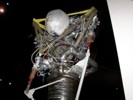

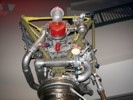
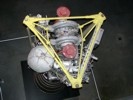
S-3 on display at the Udvar-Hazy Center.
(Photos: Richard Kruse, 2008)
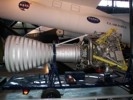
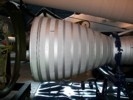

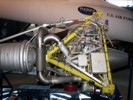
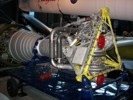
LR-101 Vernier Rocket Motor
Early Thor and Atlas rockets used two Rocketdyne LR-101 vernier engines to provide directional control.
LR-101 Vernier Rocket Motor at the Air Force Space and Missile Museum.
(Photos: Richard Kruse, 2008)
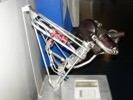
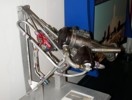
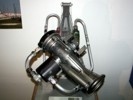
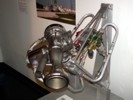
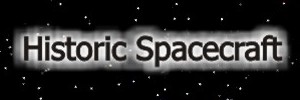
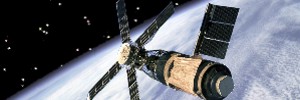














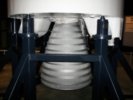
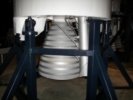
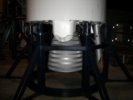
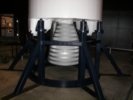












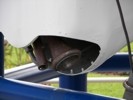
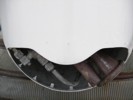


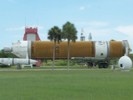
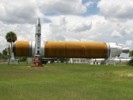
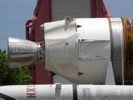
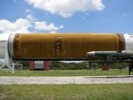
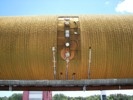






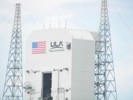


















 Images by Richard Kruse are licensed under a Creative Commons Attribution-Noncommercial 3.0 United States License.
Images by Richard Kruse are licensed under a Creative Commons Attribution-Noncommercial 3.0 United States License.